PLUMS
The most popular of the stone fruit, plums need good garden soil, slightly acid to neutral . The flowers are produced early when there is risk of frost damage so avoid frost pockets if possible or grow, fan trained, on a sunny south or west wall. Trees grown this way can easily be covered with fleece or polythene when ever frost threatens.
Plums benefit from as little pruning as possible so make sure they have the space to grow naturally with just a little formative pruning in the early years. Unlike apple and pears, never prune plums (or any other stone fruit) in the dormant winter months as infection can enter the open wounds. Small, formative pruning cuts early in life are far better than larger cuts later on.
Cropping can start in the second year after planting but doesn't really get under way until the trees are 4 to 5 years old and have produced more bud wood
CHOICE
OF ROOTSTOCKS
For years St. Julian A was the main "dwarfing" rootstock for plums but this still produced quite vigorous trees- 20 ft. or more.
Pixy is a new dwarfing stock but still manages a 10 -15 ft. tree in the open
Jaspi and Plumina are two new dwarfing stocks that are just beginning to make an appearance
but it is too early to evaluate them at present. Pollinators, where needed, are given
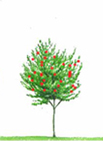
For more compact
trained trees or larger bushes

For larger trained and free standing trees
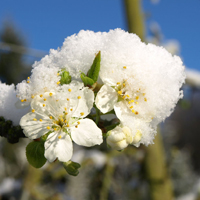
Watch out for late frosts at blossom time!
usually to order
please check
normally stocked,
Check for availability
Don't forget National Garden Scheme open days at the Trials Garden for pruning and tasting this summer.
Pick up a copy of the yellow book from the nursery
![]()
Avalon- Vigorous and slow into cropping but an excellent flavoured dessert plum,
partially self fertile. Best on pixy stock (Bristol 1980) ![]()
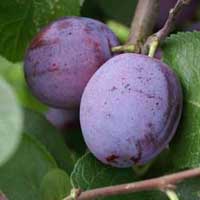
Avalon
Edda- Great dessert plum, blue skin yellow flesh and rich flavour. Use Opal or Victoria for pollinators ![]()
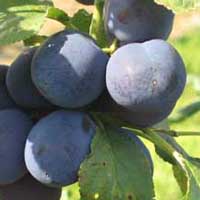
Czar
Excalibur- like a large Victoria, excellent quality but shy into cropping. Vigorous so best on pixy. Pollinated by Victoria ![]()
Guinevere-heavy cropping and easily managed. Light purple fruit and good eating qualities. Late picking, September to early October. Self fertile ![]()
Haganta- New large blue plum from Germany. Late season. Partially self fertile. Just added to the trials garden for evaluation ![]()
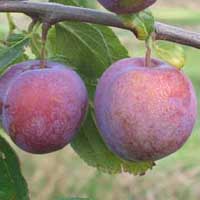
Excalibur
Jojo- a new promising variety added to the trials garden for evaluation ![]()
Jubilee- Excellent flavoured plum, a cross of Victoria and Czar with fruit similar in appearance to Victoria but larger. Strong growing, best on pixy stock. Self fertile ![]()
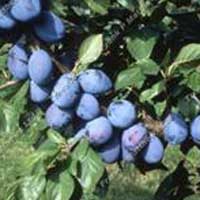
Jojo
Kirke's (Kirke's Blue)- large, dark blue, firm but rich flavoured. August picking. London 1831
Victoria is good for pollination ![]()
Marjorie's Seedling- one of the last plums to pick-as late as early October here in some years.
good culinary plum and eater with sweet flesh and blue skin. Victoria and many others for pollination. Grown as a large fan on our garden wall ![]()
Methley- a Japanese type plum (prunus salicina). Small with red flesh and a sweet, mild flavour. Very refreshing ![]()
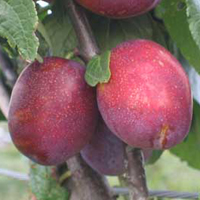
Jubilee
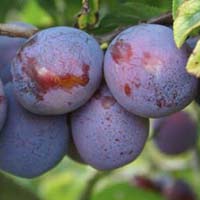
Marjorie's Seedling
Opal- probably the most reliable of garden plums. Sometimes known as early Victoria. Reddish purple fruit, superb flavour. Self fertile. Sweden 1925 ![]()
Sanctus Hubertus - one of the best cropping early varieties with large, purple blue fruit in early August. Eating or cooking. Any of the above for pollination. Grown as a large fan on our garden wall ![]()
Seneca- Picking in September, this is a large oval plum, reddish purple with yellow, sweet flesh. freestone type. New York 1937. added to the trials garden 2009 for evaluation. ![]()
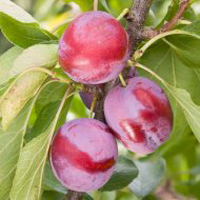
Opal
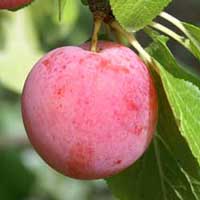
Reeves
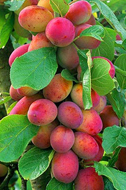
Victoria
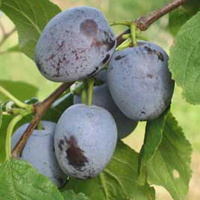
Sanctus Hubertus
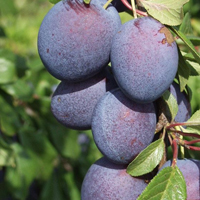
Valor